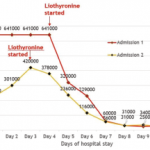Statin-Associated Myopathy
Statins are inhibitors of 3-hydroxy-3-methyl-glutaryl coenzyme A (HMG-CoA) reductase, a key enzyme in the synthesis of cholesterol. These agents have revolutionized the treatment of hypercholesterolemia and atherosclerosis, with over 100 million prescriptions written annually, and nearly $20 billion in annual sales.1,2 Statins have consistently demonstrated at least 30% reductions in cardiovascular clinical endpoints with limited drug-related adverse effects.1
Some investigators estimate that about 50% of patients who might benefit from statins are not taking them due to fear of rare but serious myopathy associated with their use.1,3,4 Statin-induced myopathy and rhabdomyolysis received significant attention in the press in 2001 when Bayer Pharmaceuticals removed cerivastatin from the market. Rhabdomyolysis and myopathy occurred more often in patients receiving a cerivastatin-fibrate combination and at higher statin doses. At the time of the cerivastatin withdrawal, the FDA had received reports of 31 rhabdomyolysis-related deaths. Overall, more than 100 deaths had been linked to cerivastatin-induced rhabdomyolysis, representing a rate of 16 to 80 times more frequent than other statins.3
Incidence
The rate of myalgia associated with statins is estimated to be 10–15%, whereas the incidence of rhabdomyolysis is much lower.1 In 2006, Law and Rudnicka systematically evaluated the rates of myopathy and rhabdomyolysis in 20 clinical trials.5 They identified a rhabdomyolysis rate of 3.4 per 100,000 person-years (for all statins except cerivastatin), with a range of 1.6–6.5 per 100,000 person-years. Additionally, the incidence of statin-induced rhabdomyolysis was higher with lovastatin, simvastatin, or atorvastatin (4.2 per 100,000 person-years), with a 10% case fatality rate. Law and Rudnicka also reported an incidence of myopathy of 11 per 100,000 person-years. Epidemiological studies have shown that rhabdomyolysis is about 12 times more common when statins are combined with fibrates.4 Fibrate monotherapy can also cause these reactions.4 A few cases of ezetimibe-related myopathy have also been reported.6
Warnings and Label Changes
In September, a Dear Healthcare Professional letter was issued by Biogen IDEC/Genentech regarding revisions to the prescribing information for rituximab (Rituxan) regarding a case of progressive multifocal leukoencephalopathy (PML).19 The patient received rituximab in a long-term safety study and developed JC virus infection with resultant PML. The patient died 18 months after receiving the last rituximab dose. Healthcare professionals treating patients with rituximab should consider PML in any patient presenting with new onset neurologic symptoms. In these cases, consultation with a neurologist, brain MRI, and lumbar puncture should be considered as clinically indicated. The warnings and precautions sections of the prescribing information as well as the boxed warning for rituximab have been updated.20


